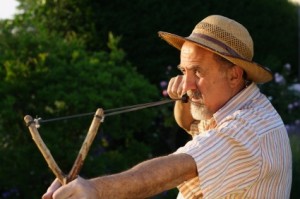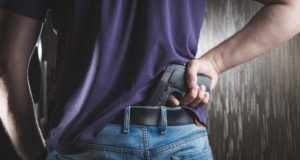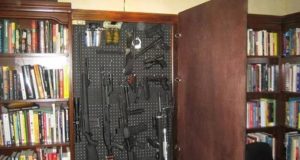 There is a reason people use firearms for defense and hunting— they just work, plain and simple. But many people in this country live in places that don’t allow firearms, or for some reason or another, they do not wish to own a firearm. There are still many ways you can make sure you are equipped to protect yourself, hunt for food, or just enjoy a fun hobby with some alternative weapons.
There is a reason people use firearms for defense and hunting— they just work, plain and simple. But many people in this country live in places that don’t allow firearms, or for some reason or another, they do not wish to own a firearm. There are still many ways you can make sure you are equipped to protect yourself, hunt for food, or just enjoy a fun hobby with some alternative weapons.
When considering alternatives to firearms, it is best to forget everything you have learned at the movies and look at what each weapon is capable of doing in the real world. The whole point of a defensive weapon is to disable or kill the person or animal attacking you as quickly and as efficiently as possible. Some so-called weapons can be worse than useless against an attacker. While I am not advocating violence, I am advocating prepping and training for real world incidents that could crop up at any time.
Black Powder
While they are still firearms, black powder weapons can still be ordered through the mail and delivered to your home without paperwork. There are many good revolver designs to choose from that are perfectly adequate for personal defense. A .44 caliber cap-and-ball revolver will have nearly the same muzzle energy as a modern .38 special.
Manufacturers make a wide range of black powder firearms starting at .22 revolving pocket pistols all the way up to large-caliber rifles or shotguns. They will take any game that a modern firearm will take. Black powder weapons do require more care and planning than standard firearms, but sometimes the advantages outweigh the little extra work.
Air Guns
When most people think of air rifles, they think of the “Official Red Ryder Carbine-Action Two-Hundred-Shot Range Model Air Rifle” from the movie A Christmas Story; however, air guns have been in existence for hundreds of years, all the way back to the sixteenth century.
Lewis and Clark took a .46 caliber air rifle on their expedition to the Pacific. They used it to take a lot of game and provide meat for the pot. Modern large-caliber air guns can be used for big game hunting.
Air guns that are just a step up from the Red Ryder can be used to take small game. Pretty much any air gun that fires a pellet instead of a BB can be used for small game. There are a plethora of pellets on the market, and you should take the time to find a type that shoots well from the gun you pick.
Most air pistols are too underpowered to consistently take game cleanly. I have used a CO2-powered air pistol to take small game like rabbits and squirrels, but with CO2 weapons, you will need to stock up on cartridges along with pellets.
I had the opportunity to shoot a higher-end .177 caliber air gun a couple years ago. It was made in Korea and had a reservoir with a gauge to tell you your air pressure. This gun sounded like a .22 long rifle when you shot it and put a hole right through one-inch pine. The owner told me it took about 800 pumps with a pump similar to an old bicycle pump to top off the reservoir. He bought an adapter that allowed him to fill it from a scuba tank.
High-end air guns cost as much as firearms and range from .177 all the way up to .50 caliber, and as I said, they can be used on big game where they are legal. They are made by small manufacturers and usually have a waiting list for those who wish to buy one.
A blowgun is an air gun of sorts. These will take very small game but really should be in the novelty class. Where they are used in real life, they are used in conjunction with poison for taking game.
I read a few years ago about making darts from bamboo skewers. The article went on to say that it would be good for defense because six inches of bamboo in someone’s neck would spoil their aim. Keep it real. Don’t get caught up in fantasy scenarios when your family’s lives may be on the line.
Edged Weapons
Knives, swords, and tomahawks fall into this category.
“Never bring a knife to a gunfight” may sound cool in training or in the movies, but in reality, if you are armed with a knife and within twenty feet or so of someone, there is a very good chance you can get to them before they have a chance to bring their firearm into play.
Everyone needs a good knife, and the variety is up to the user. Each person must determine what he or she likes to use the most. A folding knife for the pocket and a larger fixed blade for bigger tasks will see you through most situations. If you are contemplating a knife for defense, make sure the blade is long enough to reach vital organs.
Things to avoid are fantasy knives that are offered in all too many catalogs. Any knife that has holes or slots in the blade will at best pick up junk in them with use; at worst, they will be weakened and break with all the extra holes. The same goes for extra projections and points or knobs sticking out from the blade. They make it weaker and get in the way. If you get a survival knife with a saw on the back, the saw teeth do not need to be very large at all to work well. All the extra stuff will hang up if you use it to stab with, and if that happens, you may not be able to pull it back out.
One more thing to avoid is Pakistani stainless steel if possible. These knives are pretty cheaply made, but sometimes they include questionable-quality materials and craftmanship. I am sure some of these knives are fine, but the ones I have are pretty shoddy. I have a large Bowie that I picked up at a flea market for $2 (the only reason I bought it). It is a full tang knife, but if you look closely, the blade is welded to the tang instead of being one piece. With heavy use, this weld will probably fail when I need it most.
The same precautions you should take in buying a knife go for swords as well. Avoid the frilly fantasy swords since they are mostly unbalanced, brittle, and useless. Most people are not swordsmen anyway, and it is just extra weight to be lugging around when things get serious. Cane swords and hidden knives are generally considered concealed weapons and are usually not worth the hassle. They have awkward grips and are usually of shoddy workmanship.
Hatchets and tomahawks are useful tools. Even cheap ones are fine for what you will probably be using them for. A word about the fighting tomahawks though: if you get one, make sure it is one that has a blunt back. The point on the back of many of them can become buried in your enemy, and you stand a good chance of having your weapon stuck when you need it.
Archery
Both bows and crossbows fall into this category. They are quiet and have decent range and power to rely on in a survival situation.
A good bow can take any game animal you might come across. They are not so good at stopping a charging bear, but some large bears have been taken with bows. A great thing about a bow is that you can make everything you need from your local environment. The bow, string, arrows, fletching, and arrowheads can be crafted from scratch if you take the time to learn how.
Crossbows can be used by those who don’t have the shooting skills necessary to be proficient with a regular bow. Some states allow the use of crossbows for big game during archery season, while some restrict their use to firearm season.
Avoid the crossbow pistols for any serious work. They are underpowered and bulky for what they are. If you want one “just because,” knock yourself out, but don’t rely on it for protection.
Personal Defense Weapons
Pepper spray, mace, and stun guns go here. These may be good for warding off an attacker, but they won’t get you very far on offense. Of all of them, pepper spray is probably the best option, since it has some range and works well on animals as well as humans. You can get the big cans of bear spray and feel pretty confident with its stopping power on people.
Thrown Weapons
When contemplating a thrown weapon, just remember that once you throw something, it is gone until you have a chance to retrieve it.
Sharp thrown weapons such as throwing knives or martial arts throwing stars will lack the depth of penetration needed to stop an attacker, despite what you see in the movies. Some thrown weapons are just a waste for a prepper. Things like throwing stars may be fun to play with but are just extra weight in the field. At best you can hope to distract him while you try to run away.
A heavy throwing stick, however, can be used on small game. The boomerang was developed as a throwing stick. I know where I grew up in the Rockies, blue grouse could easily be taken with a throwing stick. If I were hungry in the city, the geese on the golf course would be easy pickings for a good stick. A bolo, which is a line with weights on the end, can be used the same way as a throwing stick.
Sticks and Stones
The first murder in human history was accomplished with a stone. A stone is the most basic weapon you can find. Many a time when I was younger and otherwise unarmed, I picked up good-sized rocks when I felt threatened by a dog.
A sling, with practice, will take game, and as Goliath found out, it can be used for protection against bad guys too. In fact, slingers were part of ancient armies. A slingshot will shoot stones, marbles, and steel or lead balls with good accuracy and power. I have even watched online video of people attempting to take a deer with an arrow shot from a slingshot. A .50 lead ball shot from a slingshot has considerable knockdown power.
The staff or quarterstaff is a formidable weapon in the hands of someone who knows how to use it. In 1625, Richard Peeke, an Englishman, was captured by the Spanish and put on trial. Peeke was asked how well the British would stand up to a Spanish invasion. Peeke replied the Spanish “would prove to be pullets [chickens]” The Spanish then asked him to prove it by fighting a champion swordsman.
Peeke prevailed, and the Spanish were embarrassed so they demanded he fight another swordsman. He replied he would if he could fight with “mine owne countrey weapon called the quarter-staffe.”
When two swordsmen stepped up, Peeke sarcastically asked if any more would like to join them. The Spanish asked how many, and Peeke replied “Any number under sixe.” One more Spaniard took up the challenge, and when all was said and done, Peeke was still standing, one Spaniard was dead, and the other two were injured. The point of this is to show that a quarterstaff is a powerful weapon in trained hands.
Another advantage of the quarterstaff is that it is seen as a walking stick and not a weapon by most people. Some collapsible walking sticks can be used as canes and even brought on airplanes. Canes have the same advantage as a staff in that they can be taken everywhere. There are many videos online teaching proper techniques for using sticks as weapons.
If you are looking for something a little more formidable than a quarterstaff, Native Americans had war clubs, and knights had maces. I have seen some of these with pointy things on them like I mentioned with the tomahawk. Avoid anything that might get stuck while you are trying to use it.
Avoid the Junk
I can’t say it enough: avoid the fantasy stuff, because it is just that—a fantasy. More than likely, you are not a ninja, a samurai, or a medieval knight. Now, if you want to get this stuff for fun, then by all means, go for it. But don’t stake your life and that of your family on being able to stop a bad guy with a throwing star.
Whichever type of weapon you choose to use, you must do your own due diligence to find out what is legal for you to have where you live. Then it is your added responsibility to become proficient with that weapon so that its use is not a false hope. Keep a realistic expectation of what it is capable of, and practice, practice, practice. Alternative weapons require more training and practice to become and remain proficient.
©2012 Off the Grid News
 Off The Grid News Better Ideas For Off The Grid Living
Off The Grid News Better Ideas For Off The Grid Living



